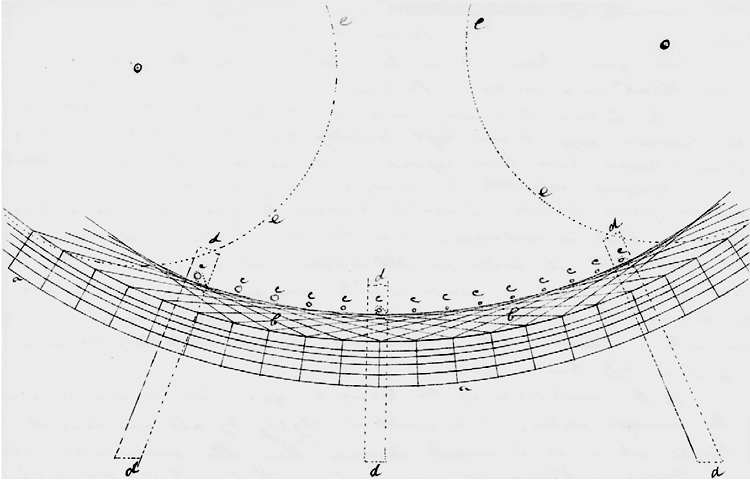To Thomas Jefferson from John Isaac Hawkins, 16 July 1802
From John Isaac Hawkins
Philadelphia July 16th. 1802
Sir,
I recd your Piano Forte on the 3d inst.—being then about to leave Philada. on a journey, I Postponed informing you till I returned.
The instrument is very much injured by wet, the Captain of the Schooner says it was kept perfectly dry while under his care, it must therefore have been exposed in coming down the river to Richmond.
Having suspended the manufacturing of instruments till my return from Europe, I would propose to you to take a Piano I have on hand, in exchange, it is the best I ever made, & one I can recommend, its price is 300 dollars. if you take it I will allow you the same for yours which you gave, viz. 250 dollars. this however I by no means wish to press, and I would rather furnish you with a Claviol but I shall not in all Probability be able to do it in less than a year.
Of the construction of the Claviol you will be able to judge by the annexed sketch; it is considered highly by all who hear it. a single note on it is much stronger, than the correspondent note on a Violin or Violoncello; so much so, that a full Chord taken by both hands is judged to be as Powerful as 12 or 15 Violins & basses. The loud sound at a distance is similar to that of a full band, in which the hearer imagines he can distinguish Clarinetts, Violins, Horns, Basses, & indeed almost every kind of musical instrument; but near, it resembles the Organ. The Piano of it is extremely soft & sweet, & has been pronounced equal to the harmonica. The Cresendo & diminuendo is Perfect.
There are some imperfections in the machinery of the Claviol which is finished, in consequence of various alterations it has undergone, that would render it almost useless to anyone but myself, I cannot therefore offer it for sale.
As I expect again to leave town in a few days shall be glad you will inform me immediately whether I shall send you the Piano Forte or not, in a line addressed to the Care of Mr. Peale at the Museum.
I am Sir yr Obt Sevt.
John I. Hawkins

| a.a.a. | part of a hoop on the inside of which horse hair [. . .] is stretched so as to form an elastic surface. |
| c.c.c. | gut strings at rest almost touching the horse hair. |
| d.d. | &c. slider moved by finger keys to draw the strings against the hair |
| The hoop is made to revolve by the foot, & the string by pressure on the finger key is brought1 against the hair, which is rosined. the tone is loud or soft according to the degree of pressure. | |
| as. the hoop could have no axis it is2 supported on 3 wheels, parts of 2 of them are represented at e.e.e. |
Sir/
I had intended to be more particular in my description but to send by this post, I must close immediately, shall take an opportunity soon to add to this: & also describe several little contrivances to save domestic labor & add to our conveniencies. being assured you take pleasure in hearing of useful improvements. yr. Obt Sevt.
John I. Hawkins
RC (DLC); torn; endorsed by TJ as received 20 July and so recorded in SJL.
TJ had shipped his daughter’s out-of-tune PIANO-FORTE to Hawkins for repair; see TJ to Hawkins, 13 Apr., and Hawkins to TJ, 21 Apr. 1802.
FURNISH YOU WITH A CLAVIOL: the claviol, a sostenete piano, contained a mechanism to prolong tones. While other inventors had devised methods to keep a piano string vibrating after a note was struck, Hawkins’s solution permitted hammers to strike a string repeatedly when a key was depressed (, v. 2, pt. 1:448). TJ suggested that he might accept a claviol if Hawkins would dispose of his piano-forte; see TJ to Hawkins, 17 June 1802. For Hawkins’s departure for London and reports that he would send claviols to TJ and Charles Willson Peale, see Mechanics’ Magazine, 43 (1845), 122–5.
1. Preceding six words interlined.
2. MS: “is is.”

![University of Virginia Press [link will open in a new window] University of Virginia Press](/lib/media/rotunda-white-on-blue.png)
